Recent Posts
-
Both mite and aphid populations have essentially been stable the past month or month and a half. Throughout this time, I only find a few adult black pecan aphids and no mites. Most of these orchards were sprayed with insecticide targeting aphids also. Finally, last week we saw one spot of mites on Stuart and…
Posted in: Insect Management -
Weed control is especially important during the tree’s first few years of growth. Orchards planted behind hay fields or in areas where bermudagrass is prominent may struggle with control. Bermudagrass is a very difficult perennial grass to control, and it’s aggressive growth can be in direct competition with young tree feeder roots getting established. Because…
Posted in: Weed Management -
We have arrived at the time of year for a number of pecan field days in the Southeast. See below for dates, locations, and contact info: August 28, 2019: SE Georgia Pecan Field Day, 8 AM-Noon lunch Location: Parker Brothers Farm, 334 Veal Camp Rd., Baxley, GA Contact Appling County Extension Office for details 912-367-8130…
Posted in: Programming -
Its time to crank up the irrigation in pecans orchards as shell hardening is completed and kernel filling begins. All irrigation systems should be at full capacity from now through mid September in orchards bearing a commercial crop. This means 3600-4000 gal/acre/day for drip and micro-sprinkler systems and 1.5″-2″ per week for solid set sprinklers.…
Posted in: Uncategorized -
Its that time again. Nothing to get alarmed about. This is from my blog plost on August 9, 2017: If you have noticed a sudden fruit shed over the last few days, you are most likely seeing the results of water stage fruit split. This is a common problem that happens annually on certain varieties…
Posted in: Uncategorized -
As a result of the detrimental effect of the current trade war and tariff situation with China, pecan growers are eligible for participation in the 2019 Market Facilitation Program, a USDA program recently announced as part of trade mitigation efforts. As opposed to the 2018 trade mitigation program, pecan farmers will receive a direct payment…
Posted in: Uncategorized -
Just a quick update here. If you have had problems with black pecan aphids (BPA) and/or anticipate having problems with them in certain blocks that are vulnerable to their infestation, spraying gibberellic acid (Pro Gibb 4%, ProGibb LV Plus) at this time of the season is an option. Gibberellic acid is a plant growth regulator…
Posted in: Insect Management
